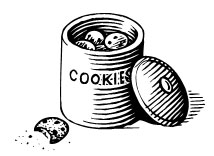
In previous resources, you’ve used probability to describe the likelihood of events occurring. You’ve also used probability to calculate the likelihood of two consecutive events occurring.
Probability is formally defined as the ratio of the number of desired outcomes (what you want to happen) to the number of total possible outcomes (what could possibly happen). Probability is a ratio, so it can be expressed as a fraction, a decimal, or a percent.
Probability = Number of Desired Outcomes over Total Number of Possible Outcomes Number of Desired Outcomes Total Number of Possible Outcomes
We can represent the probability of an event using the notation below.
P(event)

For example, out of a dozen cookies, there are 9 chocolate chip cookies and 3 sugar cookies. The probability of randomly choosing a chocolate chip cookie from the cookie jar is 9 over 12 9 12 . Since this is only one event occurring, this is called a simple event.
Using probability notation, this would be written as follows.
P(chocolate chip) = 9 over 12 9 12
Probabilities are ratios, so they can be expressed as fractions, decimals, or percents.
P(chocolate chip) = 9 over 12
9
12
P(chocolate chip) = 0.75
P(chocolate chip) = 75%
Suppose that someone selects more than one cookie from the cookie jar without looking. What is the probability that these cookies will all be chocolate chip cookies? In this resource, you will investigate different ways to answer that question.